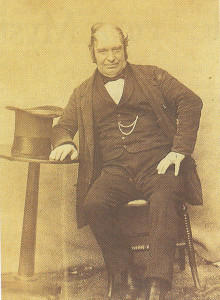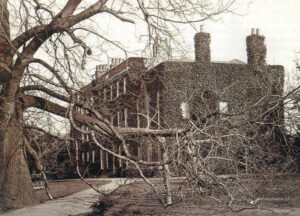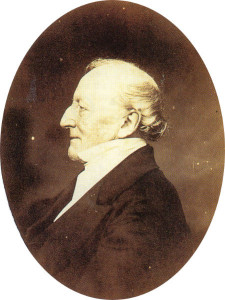
To the left off the A4 at the start of the motorway, the A315
branches off past Syon Park towards Hounslow. If you follow the road to the end of the park, you come to the A310 signposted to Isleworth. It’s a fairly normal suburban sprawl with few characteristics of special note. Aircraft roar overhead every few minutes, for it’s directly beneath the flight path for Hounslow.
To the left again, down North Street, a small enclosed park rather elaborately named Silverhall Nature Park is passed before you reach a small cul-de-sac called Silverhall Road. It consists of pleasant post-war housing, a pretty ordinary suburban development, and at this point you have to let imagination take over.
In an old volume of family news cuttings I came across a collection of sepia photographs of Silver Hall – not the housing estate of today, but a gracious stately house which was home to the Glossop family in the middle of the 19th Century, set amid a spacious garden – and with them I have come to recapture the spirit of a bygone age.
The Rev. Henry Glossop became vicar of Isleworth parish church in 1821, and he remained there for 33 years. He bought Silver Hall, which was named after the previous occupant, Miss Silver, in 1841, and it was the family home until 1888. The vicar cut a striking figure in the parish, with his prominent hooked nose and aristocratic bearing, and was fully engaged in both church and social life. In 1855, the year of his retirement, he helped oversee the building of the new church of St.John in Isleworth to which he contributed £10, no mean sum in those days.
He lived for a further 15 years, but his son took over at Silver Hall and was equally well known in the neighbourhood, being a magistrate for Middlesex and involved in numerous philanthropic and charitable associations. He took a special interest in ‘homes for destitute and neglected children’. His death in January 1886 ended the era at Silver Hall, and the house was sold two years later. I have no record of what happened to the estate after that date, nor when it was broken up to give way to the present housing estate.
Leafing through the old volumes brings another era to life. What is now grey suburban development was then specious lawns and a tennis court – there’s a faded picture of a family tennis party taking tea on the lawns. The flower garden was studded with rose bushes. Next to it was a walled garden, a kitchen garden and a paddock of two acres, with stabling for five horses and two coach houses. Majestic firs and giant elms shaded the lawns, a mulberry and silver birch graced the garden paths and a weeping willow (grown from a cutting over Napoleon’s grave in St. Helena) dipped its branches in the stream. Today’s ‘Silverhall Nature Park’ is but a relic of that former glory, but some of the trees remain, still dipping their branches into the water.
My grandmother was born in 1865 and spent her happy childhood in the gardens at Silver Hall. She was sent away to boarding school and on holiday to Switzerland, from where she wrote home dutifully:
I am enjoying myself so much here. We have had dreadfully bad weather. Bertram has been making a beautiful collection of butterflies and Char and Etty have been drying flowers, which we have found in great numbers. I have been learning to walk on stilts…
Her father wrote regularly to her at boarding school:

Glad to hear that you are convalescent – do not overwork but go on steadily. Remember the hare and the tortoise. We had a Lawn Tennis Party of young ladies yesterday! This with singing lessons and botany classes reminds one much of a girls’ school! Your mother is kept a prisoner by the east wind…
Silver Hall opened its doors regularly to host social events for the local community. On Christmas Eve 1875 the Glossop family and their friends invited the neighbourhood to a variety performance. My great grandfather read The Charge of the Light Brigade, his wife played an instrumental selection, and others sang solos or duets or recited poetry. Admission was “by penny toys only, by order of the committee”. On another evening Madame Madeleine Graver, pianist to the late Queen of the Netherlands, gave a pianoforte recital of Beethoven and Schumann. On yet another occasion the family gave ‘a Grand Amateur Performance of Puss in Boots . My grandmother, then aged ten, played the princess, and her father was the King. Such was family leisure before television.
Behind the scenes, and doubtless integral to the Victorian ideal, the kind and genteel face of the faithful family servant, Curtis the Butler – or to give him his full name John Curtis Worthington -appears in several photographs, always discreetly in the background but clearly an essential part of the family, who knew his station in life and kept it with longevity and courtesy. For half a century Curtis was always there to meet the family needs. He died soon after the home was broken up, and the local paper recorded his passing:
An old inhabitant has passed away to his rest, who will be well remembered among the ‘ancients ’ of our village.. .fifty-three years a faithful servant to the family of the late Rev. H. Glossop of Silver Hall’. What better epitaph can be written of ‘poor old Curtis’ who was kindly tended to the last by the family he loved and served so well?
Another jumbo jet screaming overhead brings us harshly back to the present day. Traffic endlessly streams down the Twickenham road and it begins to drizzle from a grey, overcast sky. Such an excursion into the past, though, gives perspective to our stressful lives. Every age has its quaint character, but some of our Victorian forebears surely enjoyed an altogether more genteel and leisurely age.
Mike Wakely









